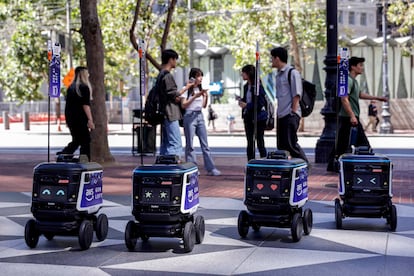“You’re inferior creatures, with poor reasoning faculties, but I really feel a sort of affection for you […] You will probably not exist much longer, but as long as you do, you shall be provided food, clothing and shelter, so long as you stay out of the control room and the engine room”
I, Robot, by Isaac Asimov. 1950
The labor market is bracing for a technological revolution, and workers are apprehensive above it. The rise of artificial intelligence (AI) is set to usher in a new era but it comes at the cost of ceding control to an unrelenting digital intellect. Will it jeopardize the current paradigm of the work ecosystem?
Some experts in technological development argue that there is no reason to fear the evolution of machines. They view it as just another technological leap, albeit one offering many more capabilities, which is capable of defining a new way of doing things. Others, however, are certain that everything will change.
Labor lawyers, for example, believe it is necessary to define the scope of new algorithms to protect the workforce. They worry that, in an ecosystem dominated by computer programs, human factors such as health may lose their importance. Business leaders, meanwhile, have a different perspective, seeing the changes as an opportunity to streamline work processes, reduce costs over time, and improve efficiency — even if it requires a significant initial investment. And many workers fear they could be replaced if they don’t adapt quickly enough.
The advances are already beginning to shape a new way of working that is being seen across various sectors. Humans and machines have peacefully coexisted but long-term projections suggest that thousands of tasks will be radically redefined. The wheel of progress is turning quietly but relentlessly.
The current distrust many people feel toward AI stems from an age-old fear of losing control — a fear that has haunted humanity ever since it became aware of its own place at the top of the evolutionary hierarchy. However, this time, it is not the threat of another species with enhanced traits that triggers this fear, but rather the boundless potential of one of humanity’s greatest inventions: technology itself. Having propelled mankind to the top, technological progress now threatens to become a double-edged sword for its creators. But hasn’t this always been the case?
“Current tools are powerful and very useful, and what they will do is mainly take care of those tedious jobs that turn many workers into robots. Contrary to popular belief, AI comes to dignify work,” says Alfonso García, professor and director of the Department of Systems Engineering and Automation at the University of Málaga in Spain.
According to García, an academic specializing in robotics, the potential of AI-driven tools did not appear overnight. It is the result of decades of experimentation. “The theoretical foundations of AI were established in the mid-20th century, but their evolution has been dramatic in recent years, largely due to the power of computer equipment that has enabled more complex algorithms, which previously had no development support,” he explains.
A qualitative leap
This ongoing progress has reached a major milestone with the advent of generative AI, which can create original content such as images, text, music, and videos — functions far beyond the basic tasks of data analysis or prediction. This new capability emerged last year and is already making a significant impact on the workforce, sparking concern among many employees.
Several surveys confirm this growing unease. According to the Boston Consulting Group, 42% of Spanish workers, for example, fear their jobs may be automated within the next decade due to advances in AI. This marks an increase from 36% in 2023. Interestingly, those who actively use these generative tools are the most aware of their capabilities, and as a result, the most concerned about the possibility of being replaced. But do they have reason to worry?

“The question is not whether artificial intelligence can replace humans or not, but when it will do so. Because it will happen,” says Agapito Ledezma, deputy director of the Master in Applied Artificial Intelligence at the Carlos III University of Madrid. “And this is just the beginning. When AI mixes with quantum computing, we can just turn it on and let it work.”
The expansion of algorithms point to the rise in capabilities that every company seeks to harness: greater production, shorter execution times, and enhanced efficiency. This potential is especially beneficial for smaller companies. According to Eurostat, 8% of SMEs are already using these tools. Broadening the scope to include the entire business landscape, a study by HubSpot, a software development and marketing company based in Cambridge, reveals that over 66% of companies in Spain have already integrated AI into their operations. For more than half of them, AI has become “fundamental” to their daily activities.

“Today the focus is on improving productivity and better use of data, but soon we will see deeper transformations that will not affect the organizational model of companies as much as the products and services that they are able to offer and develop,” says Xavier Gangonells, general director of the Spanish Association of Executives (AED). “We are already seeing use cases where productivity is improving by between 30% and 40%.”
However, handing over certain managerial powers to digital entities — as depicted in Isaac Asimov’s I, Robot, one of the most influential works of science fiction — raises ethical concerns. “I think we should be very careful about artificial intelligence. If I were to guess like what our biggest existential threat is, it’s probably that,” warned tech magnate Elon Musk, owner of Tesla and the social network X. “With artificial intelligence, we are summoning the demon.”
In the workplace, beyond the potential for replacing humans with machines, additional threats loom. “The greatest danger of deploying these tools is that they will take away your salary,” says Adrián Todolí, professor of Labor and Social Security Law at the University of Valencia, who has spent years studying the relationship between humans and algorithms. In his book Algorithms, Productive and Extractive: How to Regulate Digitalization to Improve Employment and Incentivize Innovation, Todolí warns that an over-reliance on technology to organize work schedules could diminish workers’ bargaining power in collective negotiations, shifting the balance in favor of employers. Moreover, there is a risk to workers’ mental and physical health, if they are monitored by tools “without feelings.”
In this way, the reconfiguration of labor rights appears to be the only safeguard against the new way of working, which is already upon us. “If controls are not put in place, we risk becoming subordinate to artificial intelligence, as it could eventually replace current middle managers, who are in charge for these types of tasks,” warns Todolí.

Responsible use
In the European Union, the main regulatory framework for artificial intelligence is the AI Act, which came into force two months ago. This law aims to foster the responsible development and use of AI across the region, adopting a risk-based approach that classifies systems into four categories: minimal risk, specific risk, high risk, and unacceptable risk.
The negative effects of automation on working conditions have been widely analyzed by various scholars. Among the most prominent are economists Daron Acemoglu and Pascual Restrepo, who have extensively studied the impact of robotization on the U.S. labor market. In their paper Robots and Jobs: Evidence from the US Labor Markets, they conclude that between 1993 and 2007, each new robot introduced to the labor market resulted in the loss of six jobs, while simultaneously reducing workers’ wages by 1%.
“The disaffection felt by many people towards artificial intelligence comes from the belief that the new algorithms will destroy millions of jobs, when the truth is that a lot of people will be needed around these new tools,” says Silvia Leal, an expert in new technological trends and international advisor to the OECD and the EU.
Although Leal believes the influence of science fiction films has skewed many workers’ perceptions, the reality is that tools now exist that replicate some of the qualities seen in movies. In Terminator (1984), an artificial intelligence named Skynet gains the ability to independently control the U.S. military arsenal, a concept that once seemed purely fictional. Today, however, AI-powered drones are used by various armed forces for tasks such as reconnaissance, surveillance, and even attack missions. Additionally, advanced anti-missile systems based on AI technology are now capable of detecting, tracking, and intercepting threats like enemy aircraft.
Although every film comparison exudes a certain 1980s nostalgia, reality is increasingly reflecting what was once projected in many of these films. Despite his own warnings, Elon Musk has invested billions in creating Optimus, a humanoid robot he hopes to launch for sale in less than five years, priced at $30,000. Musk envisions a future where the robot could even “take care of your children.” While Optimus is not a replicant like those from Blade Runner (1982), the goal is to design a human-like entity capable of taking over some tasks for its owners.
“Fiction has always been ahead, and these future projections we are making are far from cinematic,” agrees Ledezma. “What we need to figure out now is whether the rise of powerful AI will be the best or the worst thing that has ever happened to humanity.”
A huge market
Meanwhile, what is undeniable is the economic boom surrounding the latest jewel of technological progress. According to data from the German statistical portal Statista, the global AI market reached nearly $208 billion in 2023, a volume projected to grow to nearly $2 trillion by 2030. These gigantic valuations are driven by the rapid expansion of AI tools worldwide. A study by the consulting firm PwC reveals that 73% of companies in the United States already utilize AI in some aspect of their business.
However, many of the most revolutionary programs, such as ChatGPT, are free to use (albeit with some limitations), and most tools released to the market are open-source, allowing users to freely study, modify, and redistribute the software. “The business is not just about you using them; it’s about collecting your data first and foremost, and second, you needing specific hardware to take full advantage of their potential,” explains Ledezma.
Another concern surrounding these tools is how they acquire their vast knowledge of human thought. “All the components of a car must be approved and conform to certain quality standards. But with some of these tools this does not happen, which means that we should not trust 100% of the results they offer us,” says Professor Alfonso García.
But are workers prepared for AI to assume certain tasks in the workforce? “We are increasingly going to need employees to understand the logic of business, to be in the most human part of work and to know how to work hand in hand with technology,” says Patricia Zamacola, Technology Director of LHH Recruitment Solutions (Adecco Group). “We have to be trained and quickly adapt to the needs of the market so that it does not take us out of the equation.”
Sign up for our weekly newsletter to get more English-language news coverage from EL PAÍS USA Edition




